For more information contact Robin W. Baird at rwbaird (at) cascadiaresearch.org or see our Hawai‘i odontocete research page
From August 9 – 28, 2007 we are undertaking research off the island of Hawai‘i (the “Big Island”) in collaboration with the Wild Whale Research Foundation, and funded by the Southwest Fisheries Science Center of NOAA Fisheries (supported by the U.S. Navy N45), Scripps Institution of Oceanography, the Northwest Fisheries Science Center, and Dolphin Quest. The research team includes Greg Schorr and Robin Baird of Cascadia, Daniel Webster, Dan McSweeney and Allan Ligon of the Wild Whale Research Foundation, Erin Oleson of Scripps, Megan Ferguson of NOAA SWFSC, and a number of volunteers. Our primary goal is to obtain additional information on diving behavior of Cuvier’s and Blainville’s beaked whales, through the deployment of suction-cup attached time-depth recorders. We have a number of additional goals, including:
- Deployment of “medium-term” satellite and VHF transmitters on pilot whales, false killer whales, and beaked whales, to examine offshore and inter-island movements (in collaboration with Brad Hanson at the Northwest Fisheries Science Center and Russ Andrews of the University of Alaska, Fairbanks)
- Deployment of a HARP (High-frequency Acoustic Recording Package) to acoustically monitor cetacean presence off the west side of the island, and to survey in the area of the HARP to compare sightings of different species to acoustic detections. This is a collaborative effort with Erin Oleson at Scripps.
- Collection of skin/blubber samples from biopsies and from suction-cups for examintion of stock structure (in collaboration with Susan Chivers and Karen Martien of the Southwest Fisheries Science Center) and trophic ecology (in collaboration with Jason Turner of the University of Hawai‘i, Hilo)
- Collection of fecal samples to examine diet (a collaborative project with Mike Ford of the Northwest Fisheries Science Center, Seattle)
- Photo-identification of 10 species of odontocetes to examine residency/movements
- Collection of survey and sighting data for examination of habitat use
- Collecting dead cephalopods for trophic ecology studies
This will be our first ever survey in Hawaiian waters in August, and will now allow us to state we’ve surveyed 12 months of the year. Waters are particularly warm (~27 degrees Celcius) at this of the year, and tuna should be common (hopefully attracting false killer whales to our study area).
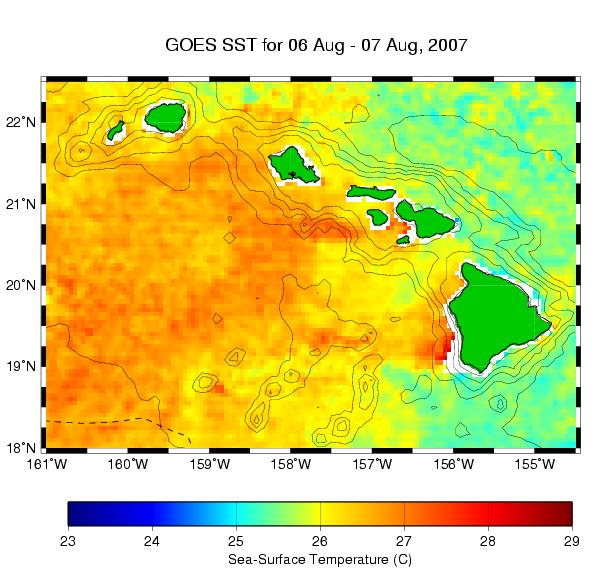
Sea surface temperature data from the NOAA OceanWatch – Central Pacific site.
The most recent updates are at the bottom of the page.
August 10 update
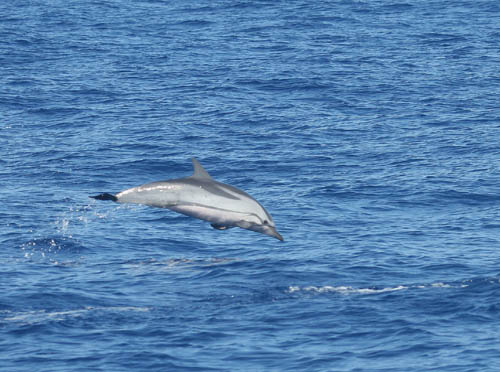
Striped dolphin leaping off Kona, August 9. Photo by Greg Schorr
Day 2 of our trip, we’ve covered 278 km of trackline, most of it in reasonably good sea conditions (Beaufort 3 or less). Our first sighting of the trip was a group of striped dolphins, quite surprising as this species is only infrequently seen off the big island (only 9 sightings out of 581 odontocete sightings from our previous surveys). We usually see striped dolphins in very deep water (>3000 m) – this was one of our shallower sightings of this species in only ~2500 m of water. Unfortunately striped dolphins in Hawaiian waters (and most other areas in the Pacific) tend to be vary wary of boats, so our view was a brief one as the dolphins moved away.
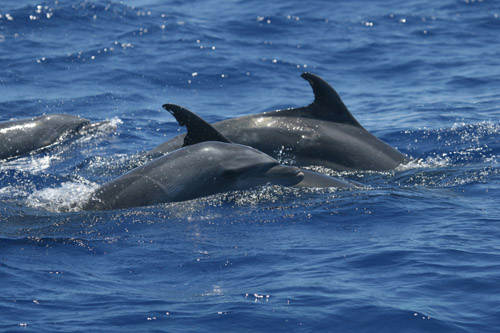
Bottlenose dolphins off Kona, August 9. Photo by Greg Schorr
We also had a large group of bottlenose dolphins (~28 individuals) and we were able to photo-identify most individuals (a lot of very well-marked individuals) as well as collect 4 biopsy samples for genetic and stable isotope studies. We collected our first squid of the trip, a small one (possibly Histioteuthis) floating at the surface being scavenged by a Bulwer’s petrel (we use the bird’s feeding behavior as a cue to look for dead squid).
We had three cetacean sightings on August 10 (more bottlenose dolphins and two groups of pantropical spotted dolphins), and were also able to deploy the HARP (High-frequency Acoustic Recording Package) in about 650 m of water, south of Honokohau Harbor. This recording package will sit on the bottom, with the hydrophone suspended by a float about 25 m above the bottom, recording continuously for the next 60 days or so. The HARP has an acoustic release mechanism, and will be recovered (we hope) in October by NOAA Fisheries Pacific Islands Fisheries Science Center. Over the next 17 days we will survey in the area of the HARP regularly to be able to compare acoustic to visual detections.
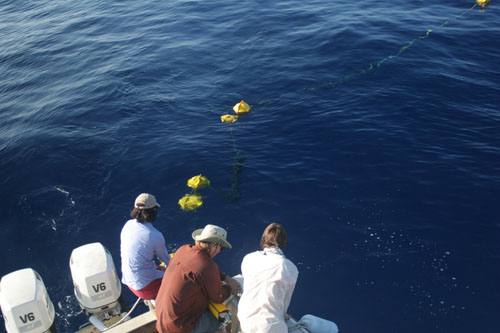
Deployment of the HARP off Kona, August 10. Photo by Robin Baird
On both days we’ve also come across extensive slicks of what appears to be decomposing phytoplankton or perhaps coral spawn, extending for many miles along current lines. We’ve collected a sample of this material and hope to have it identified.

August 12 update
While there have been few sightings in the last two days (only 4 in 279 km of trackline), it has been quite productive nonetheless. We encountered a large group of rough-toothed dolphins (~45 individuals), and were able to obtain dorsal fin photographs of 25 or more individuals to add to our photo-identification catalog of this species. On average rough-toothed dolphins are the 6th-most common species of odontocete we encounter off the Big Island, and we have a catalog of 337 distinctive individuals from around the main Hawaiian Islands. These photos will be compared to the 124 distinctive individuals previously documented off the Big Island as well as others off of Kaua‘i and O‘ahu to assess site fidelity and movements among the islands.

Rough-toothed dolphins August 11. Photo by Greg Schorr
We also had our first encounter with short-finned pilot whales of the trip – a group of ~25 individuals including three adult males. We were able to deploy two satellite-tags (using Wildlife Computers Spot-5 transmitters) and one VHF-radio tag (a Sirtrack transmitter) on individuals in this group (two on adult males and one on a sub-adult). These are “medium-term” tags, expected to stay on and transmit for 1-2 months. We will hopefully receive locations of the whales once or more per day via signals transmitted to orbiting ARGOS satellites, allowing us to examine movements of pilot whales among the islands, as well as examining their offshore range and movements around the islands (to the windward sides, where we are unable to survey).
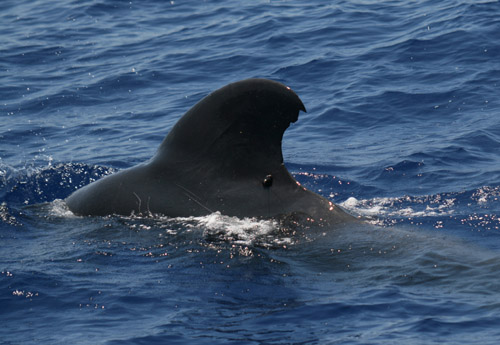
Adult male short-finned pilot whale with satellite tag, August 11. Photo by Daniel Webster.
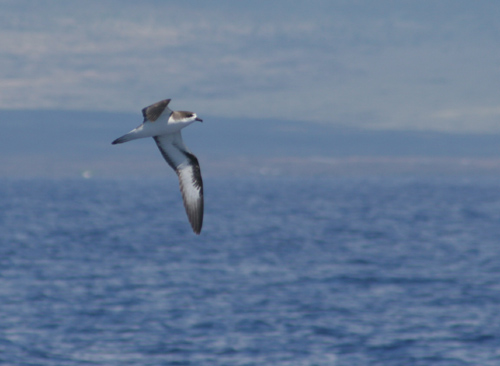
Hawaiian petrel off Kona August 11, Photo by Robin Baird. Thanks to Peter Pyle for confirming the identification of this sighting.
August 14 update
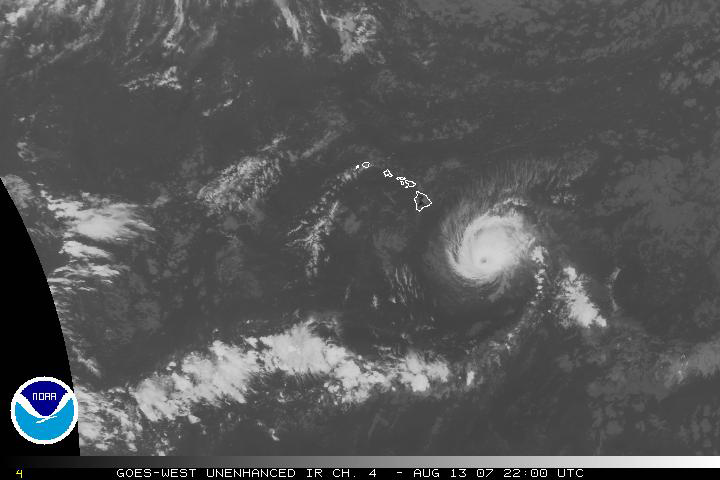
We are staying on land today.
A good day yesterday – we encountered a group of pygmy killer whales, a species we see relatively infrequently, despite the fact that photo-identification data indicate this species show high fidelity to the area. Photographs from this group were matched to our catalog today by Sabre Mahaffy – this was a group we’ve seen previously off the island of Hawai‘i (HIFa006, HIFa008, HIFa009, HIFa278, and probably HIFa279). Little is known about this species’ behavior or ecology – yesterday we attempted to deploy a suction-cup attached time-depth recorder to examine diving behavior (nothing is known of the diving behavior of this species). One tag was deployed, but stayed on for less than two minutes, and the individual dove only to 18 m. Probably a good thing that the tag came off so quickly, given the approach of Hurrican Flossie (which could have *complicated* the recovery of a tag that stayed on an extended period).
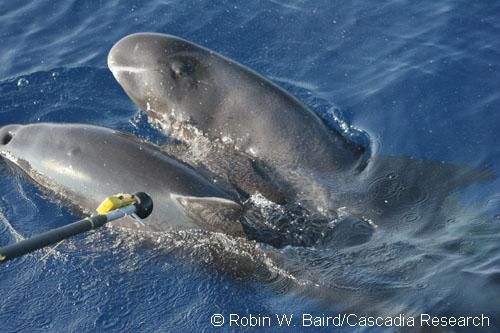
Pygmy killer whales off Kona prior to tag deployment, August 13. Photo by Robin Baird.
Later in the day we encountered a dispersed group of ~25 short-finned pilot whales, and were able to deploy another medium-term satellite tag, as well as a medium-term VHF tag (which should allow us to re-locate the group if they are within our study area). We are continuing to receive satellite locations from the first two tags deployed a few days ago – both whales have moved up to the north end of the island. During the pilot whale sighting we also observed a breeding plumage Franklin’s gull, a relatively rare species for this time of the year (gulls are quite uncommon in Hawai‘i, with no breeding species). We are looking forward to getting back out onto the water after the hurricane passes!
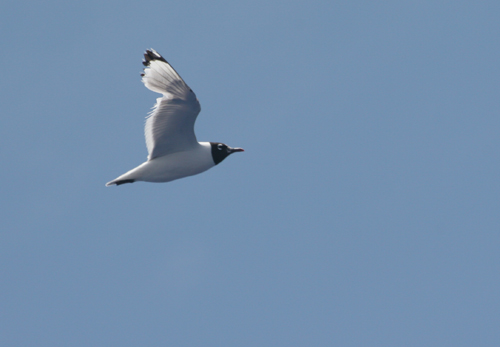
Franklin’s gull off Kona, August 13. Photo by Robin Baird.

Pilot whale spyhopping, August 13. Photo by Daniel Webster.
August 16 update
Back on the water after “hurricane” Flossie passed by the island – mostly a non-event for us. Other than a larger swell than normal, we experienced little of the hurricane on the west side of the island.
Yesterday we had our first beaked whale sighting for the trip, a lone Blainville’s beaked whale. First spotted at a distance of about 550 m, by the time we approached the whale had dove, although we were able to see it sub-surface for several minutes before it finally went deep. We typically will wait for up to 90 minutes after a beaked whale sighting to try to re-sight the group (the longest dive we’ve recorded from an individual instrumented with a time-depth recorder is 90 minutes). After waiting an hour the whale was re-sighted ~1.4 km away, and by the time we approached it had dove again. Splashes seen half an hour later in the distance turned out to be a pair of striped dolphins (an unusual sighting – striped dolphins are typically seen in much larger groups, and in Hawai‘i at least, in deeper water).
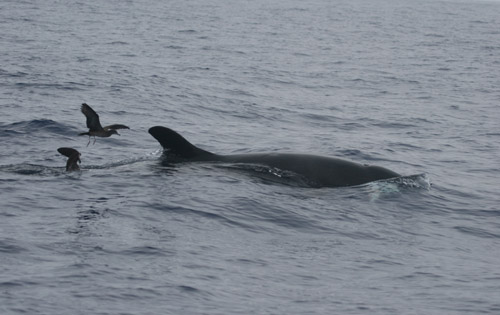
False killer whale carrying fish followed by wedge-tailed shearwaters. Photo by Erin Oleson.
Just as we were heading back into the harbor in the afternoon we received a call of false killer whales south-bound off the Kailua-Kona airport. Heading back out we were able to locate the group, photo-identify 7 or 8 individuals, deploy three satellite tags, and collect two biopsy samples (for genetics studies). A good day on the water.
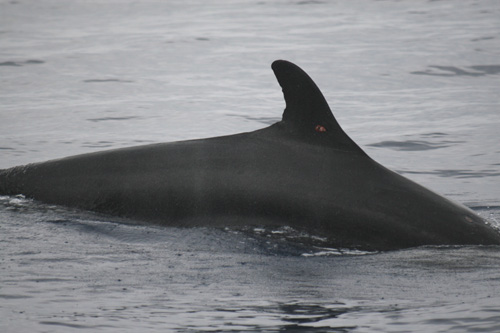
False killer whale with satellite tag. Photo by Daniel Webster.
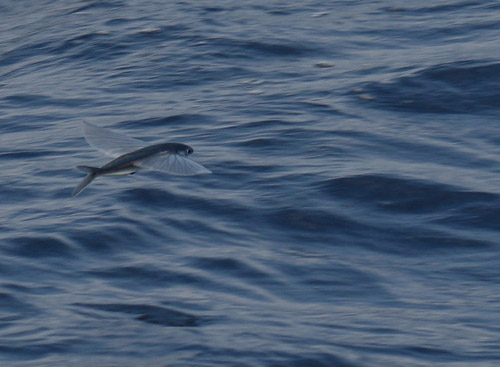
Flying fish. Photo by Daniel Webster.
August 18 update
Our last two days on the water have brought the cetacean species total for the trip up to 11, with sightings of both dwarf and pygmy sperm whales. Dwarf sperm whales are fairly common off the island of Hawaii (we’ve had 21 previous sightings of this species in the area, since starting work here in 2002), but this is only our second sighting of a pygmy sperm whale off this island, and only our third ever in Hawaii. As are most sightings of dwarf and pygmy sperm whales, these were brief, with a quick glimpse of the animals before they dove, but we were able to get photos of both to confirm species.

Leaping juvenile pantropical spotted dolphin with remora. Photo by Daniel Webster.
Since our March/April 2006 trip to the big island we have been collecting dead floating squid and octopus, both for trophic ecology studies (a collaborative project with Jason Turner at UH Hilo analyzing stable isotopes), and to assess what species of squid are in the area and potentially available as prey of beaked whales, pilot whales, and other squid-eating odontocetes. Our primary cue for spotting these squid are scavenging seabirds.
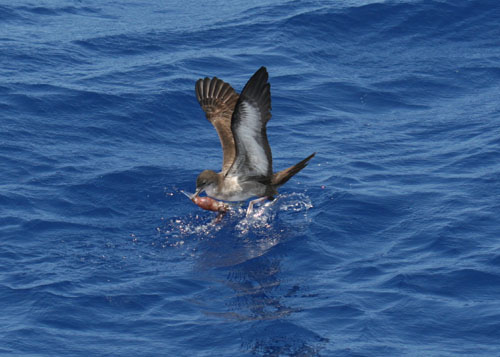
Wedge-tailed shearwater attempting to eat live squid. Photo by Daniel Webster.
So far this trip we’ve collected four individual squid, three over a two-day period. The last collected is certainly the largest cephalopod we’ve collected (out of ~14), weighing at least 30 lbs and with the two longest arms approximately 7′! All are now frozen and waiting to be shipped to Bill Walker at the National Marine Mammal Laboratory in Seattle for identification.
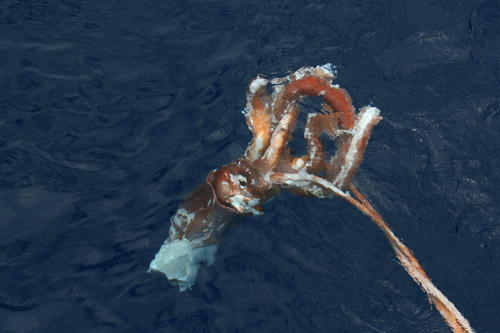
Large squid found floating off Kona. Photo by Daniel Webster.
August 20 update
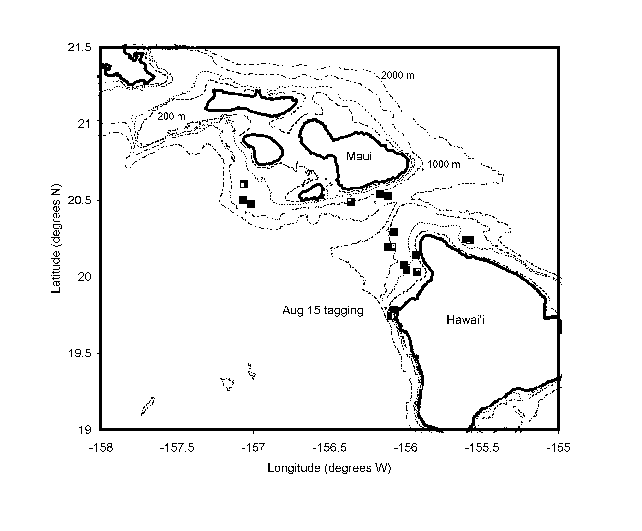
Map showing locations of a tagged false killer whale from August 15 through August 19, 2007.
August 25 update
The highlight of the last few days was our first-ever sighting of Longman’s beaked whale in Hawaii. A group of ~30-35 individuals was first seen (and photographed) by Dan McSweeney – we were able to get out to the group and get a look before they dove. Despite searching in the area for two hours afterwards we were unable to re-locate the group. To our knowledge this is the first confirmed sighting of this species off the main Hawaiian Islands and only the second confirmed sighting of this species in Hawaiian waters.
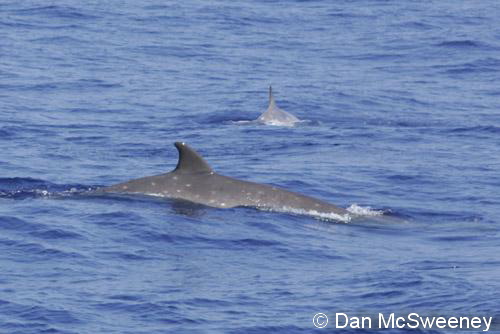
Longman’s beaked whale (Indopacetus pacificus) off Kona. Photo by Dan McSweeney.

Longman’s beaked whale off Kona showing beak of one individual. Photo by Dan McSweeney.
End of the trip update
Today was our last day on the water for this trip. Over the last 19 days we’ve spent 130.5 hours on effort, covering 2,275 km of trackline off the Kona coast of the big island. During this time we’ve had 50 sightings of 12 species of odontocetes, taken approximately 13,000 photographs (for either individual or species identification), collected 16 genetic samples of five species (14 from biopsies, 2 sloughed skin samples from suction-cup attached tags), and have collected five squid (including one Architeuthis, see photo above). After 12 days we are still receiving daily locations from two of the three satellite tagged false killer whales, tracking their movements as the move among the Hawaiian Islands. We’ll add a few more highlight photos from the trip over the next week.
All photographs on this page are taken under NMFS Scientific Research Permits and are copyrighted and not to be used without permission.